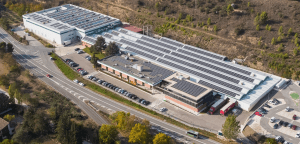You know those ambiguous images where if you focus one way, you’ll see one thing, but if you look at it another way, an entirely different image pops out? The one of the young woman with the cloaked head comes to mind. If you look again, you’ll discover that there really is an aged woman lurking in that optical illusion as well.
A more obvious one of these “bi-stable” visuals is what’s known as the “Rubin vase.” Is it a vase? Or two faces? Two faces? Or a vase? And so on…
The success of the Rubin vase lies in its ability to highlight the inner-workings of figure-ground perception—that is, seeing a figure against a background and vice versa. It goes without saying that the figure and background are essentially interdependent.
Well, the same is true of your data center’s IT and facilities systems. Today’s data centers must be dynamic and responsive to changing business requirements. And they simply can’t be if IT and facilities each exist in their own silos, and are managed accordingly. The two must work together in a mutually supportive way if data centers truly are going to be responsive to the business itself.
We all know, for example, that cooling inefficiency is one of the most common causes of a data center’s over consumption of energy and, in turn, heightened OpEx. Why? The answer is simple: because IT room and facilities cooling systems historically work disharmoniously—without good flow. They lack a dynamic relationship that could optimize efficiency and cut costs.
Today, there is a way to enable an interconnected relationship between facilities and IT physical infrastructure—and to actually see both spaces at once and manage them in concord. It’s Schneider Electric StruxureWare for Data Centers software.
This data center infrastructure management (DCIM) software goes beyond the “talk” of harmonious interaction between IT and facilities and gives both parties an actual tool to take action, to walk the talk.
You can think of StruxureWare for Data Centers software as the frame of the Rubin vase picture—the frame that enables IT and facilities to converge within the same visual field and work interdependently.
With such a frame, what do you see now?
- Energy cost and consumption at the macro or micro level so you can collect, analyze, and report on your energy
- Power usage effectiveness (PUE) and dozens of other relevant key performance metrics in real-time from across the IT and facilities physical infrastructure
- The impact of pending moves and changes on power capacity and cooling distribution
- A simulation of the consequences of power and cooling device failure on IT equipment so you can identify the impact on critical business applications
- Graphical representations of electrical, mechanical, and IT equipment to ensure comprehensive and intuitive usability
- Power quality, capacity limitations, generator test results, equipment inventories, and more reports
- Energy use details that enable the linking of operating costs to each business unit user group, thereby allowing for “charge backs”
- Excess capacity, meaning devices that can either be decommissioned or used elsewhere
- Power, cooling, rack and other physical infrastructure information integrated with a VM manager to ensure virtual servers are supported by “healthy” physical hosts
In the end, what will the business see? Optimized capacity and IT assets, lower energy use, better ROI, deferred CapEx potential, a responsive data center, and reduced OpEx. Now that’s a work of data center art!



